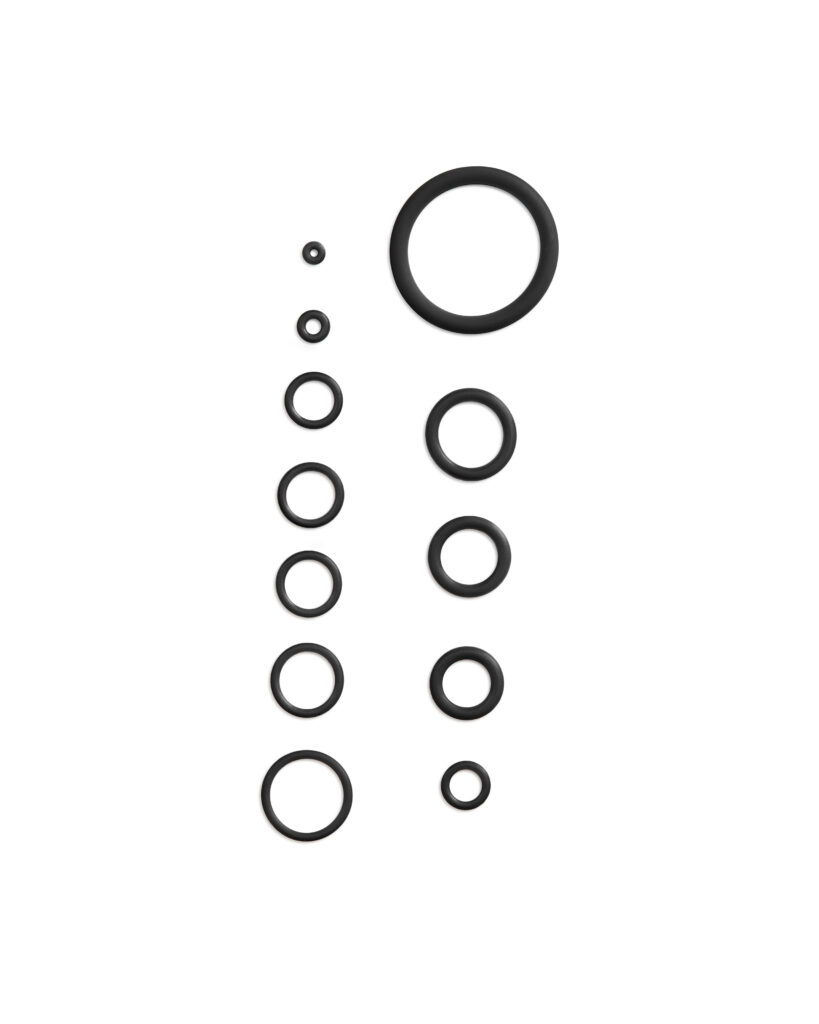What is an O-Ring and Why is it Important to Scuba Diving?
An o-ring is a circular shaped gasket used to seal two working surfaces together. In scuba diving the o-ring is a critical part to making your equipment operate safely allow for you to dive without worry. O-rings are not created equal! There are a number of differences in material, hardness, and size that are very important to understand. Picking the wrong type of o-ring for your dive kit can lead to failure under pressure. Additionally over time because of the nature of material used to make o-rings they dry out and develop cracks over time. Which is why it is important to check and replace your o-rings at regular intervals and be ready with a fresh supply of o-rings in your save-a-dive kit. Also don’t forget to replace your save-a-dive kit supply of o-rings every few years to prevent additional failures and lost dives!

What are the Common O-Ring Material Types for Scuba Diving?
The most common types of o-rings used for scuba diving are made of various materials. Below is a list of the most common scuba o-ring materials.
FKM / FPM / Viton – Viton is a trade name of Dupont but these Fluorocarbon Elastomers are also called FPM or FKM o-rings. They are all the same! These are much more oxygen resistant and are typically recommended for inclusion in your save-a-dive kit as they are considered Nitrox compatible and better than the inexpensive nitrile o-rings. FKM o-rings have very good chemical resistance, oil resistance.
Nitrile – This is a common hydrocarbon based synthetic rubber, with good durability and resistance to oils and acids. Also called Acrylonitrile-Butadiene Copolymers (NBR). It is important to note that nitrile is not very oxygen resistant – therefore if you dive a lot of nitrox with increased oxygen percentages you may want to look to have o-rings in your save-a-dive kit made from other materials.
Polyurethane – You don’t find a lot of these o-rings in scuba diving, they are milky white in appearance and typically only used in K-valves because they are extremely durable and can support very high pressures.
EPDM – Ethylene Propylene Diene Monomer are increasingly being used in scuba diving because it can be considered safer for breathing systems. It is not considered as durable as FKM o-rings and is not recommended to use with oil based products (so lubricants can lead to quick deterioration of these o-rings).
Did you know our ultimate save-a-dive kit has all the o-rings you need!
Does O-Ring Hardness Matter?
Depending on what the purpose of the o-ring is and where it is used within your scuba equipment different hardnesses are recommended. O-ring hardness is defined by durometer. A durometer rating of 70 is considered soft while a rating of 90 is considered stiff or hard. You want softer o-rings in places where the two moving parts meet – like an SPG swivel or regulators. Harder o-rings are best for more static applications like use on a tank. A quick note about color. Many o-rings are black sometimes you will find FKM/FPM o-rings in brown which is helpful for distinguishing them from nitrile ones, and EPDM ones are sometimes purple. However the color of an o-ring is really not important and does not tell you a lot. You can easily have black FKM/FPM or EPDM o-rings.
O-Ring Sizes and Measurements:
You will typically see two different designations for o-ring sizes the S.A.E and the British BS-1806 standard. For most scuba uses you look at the last three numbers for the size. See the chart below for some details on the stands sized o-rings and their application.
OD – is the outside diameter (the diameter from outside to outside)
ID – is the inside diameter (the diameter from the inside edge to inside edge)
CS – is the cross section of the o-ring (essentially the OD – ID)
| Type | OD | ID | CS | Typical SCUBA Application |
| BS1806-214 | 1-1/4″ | 1″1.000″ | 1/8″0.139″ | Cylinder with Large Neck/Valve (3/4″ NPS)(All Aluminum, most Steel cylinders)Duro: 90A |
| BS1806-116 | 15/16″ | 3/4″0.750″ | 3/32″0.103″ | Cylinder with Small Neck/Valve (7/8″ UNF)(“Genesis” 3500 psi Steel cylinders)Duro: 90A |
| BS1806-112 | 11/16″ | 1/2″0.500″ | 3/32″0.103″ | Standard DIN Regulator/Valve(Mosl DIN regulators)Duro: 90A |
| BS1806-111 | 5/8″ | 7/16″ | 3/32″0.103″ | Small DIN Regulator/Valve and Old Yoke Valves Duro: 75A |
| BS1806-110 | 9/16″ | 3/8″ | 3/32″0.103″ | MDE Yoke ValvesDuro: 75A |
| BS1806-015 | 11/16″ | 9/16″ | 1/16″0.070″ | Cylinder Valve Bonnet NutDuro: 75A |
| BS1806-014 | 5/8″ | 1/2″0.500″ | 1/16″0.070″ | Standard Yoke Regulator/K-valveDuro: 75A |
| BS1806-013 | 9/16″ | 7/16″ | 1/16″0.070″ | Large Low-Pressure Port/Hose (1/2″ UNF)Duro: 75A |
| BS1806-012 | 1/2″ | 3/8″ | 1/16″0.070″ | High-Pressure Port/Hose (7/16″ UNF)Manifold and Manifold Port PlugsDuro: 90A |
| BS1806-011 | 7/16″ | 5/16″ | 1/16″0.070″ | Standard Low-Pressure Port/Hose (3/8″ UNF)Duro: 75A |
| BS1806-010 | 3/8″ | 1/4″0.250″ | 1/16″0.070″ | Low-Pressure Hose/2nd Stage Regulator Cylinder Valve StemDuro: 75A |
| BS1806-006 | 1/4″ | 1/8″0.125″ | 1/16″0.070″ | BC Power InflatorDuro: 75A |
| BS1806-003 | 3/16″ | 1/16″ | 1/16″0.070″ | High-Pressure Hose/SPG swivelDuro: 90A |
Should you Lubricate Your O-Rings?
There is some debate in the industry of using silicone grease on o-rings where enriched oxygen is used. O-rings used in static situations don’t really need lubrication, dynamic o-rings should be lubricated but make sure you don’t use too much lube as the excess lubrication can accumulate and block ports within your regulator or SPG.